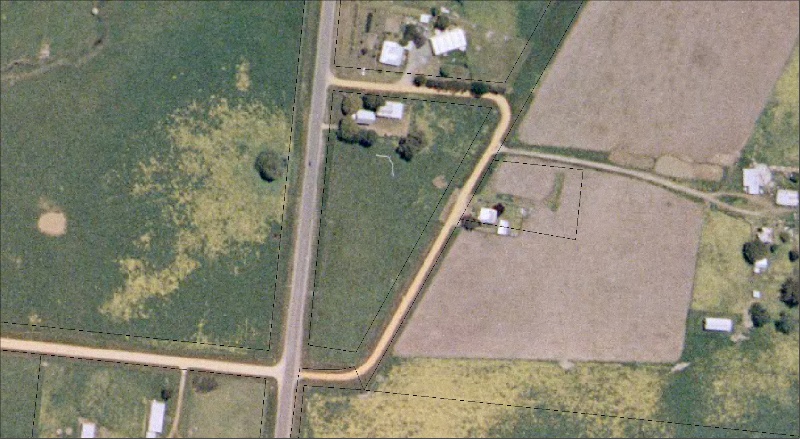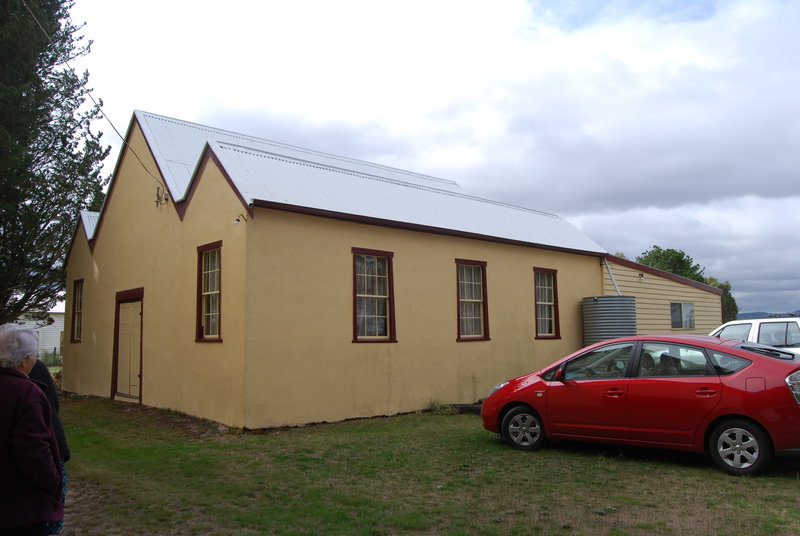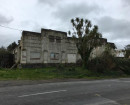FORMER BLACK LEAD UNITING CHURCH AND HALL
5050 COLAC-BALLARAT ROAD CAMBRIAN HILL, GOLDEN PLAINS SHIRE
-
Add to tour
You must log in to do that.
-
Share
-
Shortlist place
You must log in to do that.
- Download report





Statement of Significance
What is significant?
The former Black Lead Uniting Church and Hall is a pair of Methodist buildings dating from 1862 and 1913. Black Lead and Cambrian Hill, located between Ballarat and Buninyong, were thriving settlements during the early gold rushes around Ballarat and following the opening up of the Black Lead goldfield in 1856. Regular Wesleyan services were being conducted from 1856 in Black Lead, and by 1860 a small Wesleyan chapel was in use. This was replaced by a new church in 1862. The new church was built near Glasson's Lane on a small block of land donated by a parishioner T C Barrett. A design by a Mr Gibson was accepted in preference to local architect J A Doane. Alterations and extensions to the church were carried out in 1863 and 1865. In July 1912 the congregation decided to erect a new church on land donated by William Barrett, and the original church, to become a hall, was jacked up and hauled about 500m to the current site by a team of horses.
The 1913 timber church building measures approximately 12m by 8m and externally is quite plain, with a simple narthex at the west end, a steeply pitched roof covered with galvanised iron, and weatherboard walls with lancet windows. Internally the church has been little altered. The raked floor, timber dado wainscoting, decorative pressed metal lined walls with cornices, and raked timber ceiling are all intact and retain original paint and decorative schemes and finishes. The leaded windows all incorporate simple geometric and art nouveau inspired coloured glass. Furniture includes original pews, a kneeling rail and a highly ornate pulpit in the Corinthian style that originally came from the Baptist Church in Collins Street, Melbourne and was purchased by the Methodists from the Ballarat Water Commission in 1912.
The former 1862 church, now the hall, is also of timber construction with weatherboards, but was rendered over by a cement skin in the 1950s, perhaps over chicken wire. The building is arranged with a triple gable roof, covering a mainnave with subsidiary aisles. The roof is galvanised iron over the original shingle covering, and openings are eight single hung twelve pane sash windows. There is a modern skillion addition at the rear. The building is timber lined throughout, with simple square posts carrying collar ties in the main hall, with access to the aisles through shallow arches linking the posts. The 19th century additions were removed when the building was relocated, and the building has also lost its original timber buttresses.
The Black Lead Wesleyan Methodist Church joined the Methodist Church of Australasia in 1902 and then became part of the Uniting Church in Australia in 1977. In 1998 the church closed and became the property of the Napoleons and District Historical Society.
How is it significant?
The former Black Lead Uniting Church and hall is of architectural and historical significance to the State of Victoria.
Why is it significant?
The former Black Lead Uniting Church and hall is of architectural significance as a pair of intact Methodist buildings from 1862 and 1913. By the 1860s many Methodist churches around the goldfields were constructed in brick, and the 1862 former Black Lead church represents a less familiar form of construction. Both buildings have a high level of integrity, including original shingles beneath later corrugated iron roofing of the hall. The 1862 hall is unusual for its triple gable form and lack of obvious religious expression. The 1913 church, whilst quite plain externally has a rich interior that has been barely altered since construction. The pressed metal walls with factory painted finish are particularly significant. The pulpit, originally from the Collins Street Baptist Church, is an unusual and highly elaborate object to find in a small rural church.
The former Black Lead Uniting Church and hall is of historical significance as a pair of buildings that represent the importance of religious non-conformism and Wesleyan Methodism on the nineteenth century Victorian goldfields.
-
-
FORMER BLACK LEAD UNITING CHURCH AND HALL - History
Contextual History:History of Place:
The original Wesleyan church of 1862 became the church hall in 1913 when the present church was built.FORMER BLACK LEAD UNITING CHURCH AND HALL - Plaque Citation
The former Black Lead Methodist Church (1913 ) with richly intact interior, and the hall, originally a church (1862), demonstrate the strength of religious non-conformism and Wesleyan Methodism on the Victorian goldfields.
FORMER BLACK LEAD UNITING CHURCH AND HALL - Permit Exemptions
General Exemptions:General exemptions apply to all places and objects included in the Victorian Heritage Register (VHR). General exemptions have been designed to allow everyday activities, maintenance and changes to your property, which don’t harm its cultural heritage significance, to proceed without the need to obtain approvals under the Heritage Act 2017.Places of worship: In some circumstances, you can alter a place of worship to accommodate religious practices without a permit, but you must notify the Executive Director of Heritage Victoria before you start the works or activities at least 20 business days before the works or activities are to commence.Subdivision/consolidation: Permit exemptions exist for some subdivisions and consolidations. If the subdivision or consolidation is in accordance with a planning permit granted under Part 4 of the Planning and Environment Act 1987 and the application for the planning permit was referred to the Executive Director of Heritage Victoria as a determining referral authority, a permit is not required.Specific exemptions may also apply to your registered place or object. If applicable, these are listed below. Specific exemptions are tailored to the conservation and management needs of an individual registered place or object and set out works and activities that are exempt from the requirements of a permit. Specific exemptions prevail if they conflict with general exemptions. Find out more about heritage permit exemptions here.Specific Exemptions:General Conditions: 1. All exempted alterations are to be planned and carried out in a manner which prevents damage to the fabric of the registered place or object. General Conditions: 2. Should it become apparent during further inspection or the carrying out of works that original or previously hidden or inaccessible details of the place or object are revealed which relate to the significance of the place or object, then the exemption covering such works shall cease and Heritage Victoria shall be notified as soon as possible. Note: All archaeological places have the potential to contain significant sub-surface artefacts and other remains. In most cases it will be necessary to obtain approval from the Executive Director, Heritage Victoria before the undertaking any works that have a significant sub-surface component. General Conditions: 3. If there is a conservation policy and plan endorsed by the Executive Director, all works shall be in accordance with it. Note: The existence of a Conservation Management Plan or a Heritage Action Plan endorsed by the Executive Director, Heritage Victoria provides guidance for the management of the heritage values associated with the site. It may not be necessary to obtain a heritage permit for certain works specified in the management plan. General Conditions: 4. Nothing in this determination prevents the Executive Director from amending or rescinding all or any of the permit exemptions. General Conditions: 5. Nothing in this determination exempts owners or their agents from the responsibility to seek relevant planning or building permits from the responsible authorities where applicable. Regular Site Maintenance : The following site maintenance works are permit exempt under section 66 of the Heritage Act 1995: a) regular site maintenance provided the works do not involve the removal or destruction of any significant above-ground features or sub-surface archaeological artefacts or deposits; b) the maintenance of an item to retain its conditions or operation without the removal of or damage to the existing fabric or the introduction of new materials; c) cleaning including the removal of surface deposits, organic growths, or graffiti by the use of low pressure water and natural detergents and mild brushing and scrubbing; d) repairs, conservation and maintenance to plaques, memorials, roads and paths, fences and gates and drainage and irrigation. e) the replacement of existing services such as cabling, plumbing, wiring and fire services that uses existing routes, conduits or voids, and does not involve damage to or the removal of significant fabric. Note: Surface patina which has developed on the fabric may be an important part of the item's significance and if so needs to be preserved during maintenance and cleaning. Note: Any new materials used for repair must not exacerbate the decay of existing fabric due to chemical incompatibility, obscure existing fabric or limit access to existing fabric for future maintenance. Repair must maximise protection and retention of fabric and include the conservation of existing details or elements. Fire Suppression Duties : The following fire suppression duties are permit exempt under section 66 of the Heritage Act 1995, a) Fire suppression and fire fighting duties provided the works do not involve the removal or destruction of any significant above-ground features or sub-surface archaeological artefacts or deposits; b) Fire suppression activities such as fuel reduction burns, and fire control line construction, provided all significant historical and archaeological features are appropriately recognised and protected; Note: Fire management authorities should be aware of the location, extent and significance of historical and archaeological places when developing fire suppression and fire fighting strategies. The importance of places listed in the Heritage Register must be considered when strategies for fire suppression and management are being developed. Weed and Vermin Control : The following weed and vermin control activities are permit exempt under section 66 of the Heritage Act 1995, a) Weed and vermin control activities provided the works do not involve the removal or destruction of any significant above-ground features or sub-surface archaeological artefacts or deposits; Note: Particular care must be taken with weed and vermin control works where such activities may have a detrimental affect on the significant fabric of a place. Such works may include the removal of ivy, moss or lichen from an historic structure or feature, or the removal of burrows from a site that has archaeological values. Landscape Maintenance : The following landscape maintenance works are permit exempt under section 66 of the Heritage Act 1995, a) landscape maintenance works provided the activities do not involve the removal or destruction of any significant above-ground features or sub-surface archaeological artefacts or deposits; b) watering, mowing, top-dressing and fertilising necessary for the continued health of plants, without damage or major alterations to layout, contours, plant species or other significant landscape features; c) pruning to control size, improve shape, flowering or fruiting and the removal of diseased, dead or dangerous material, not exceeding 20% of the crown of the tree within a period of two years; d) tree surgery by a qualified horticulturalist or tree surgeon necessary for the health of those plants. Public Safety and Security : The following public safety and security activities are permit exempt under section 66 of the Heritage Act 1995, a) public safety and security activities provided the works do not involve the removal or destruction of any significant above-ground structures or sub-surface archaeological artefacts or deposits; b) the erection of temporary security fencing, scaffolding, hoardings or surveillance systems to prevent unauthorised access or secure public safety which will not adversely affect significant fabric of the place including archaeological features; c) development including emergency stabilisation necessary to secure safety where a site feature has been irreparably damaged or destabilised and represents a safety risk to its users or the public. Note: Urgent or emergency site works are to be undertaken by an appropriately qualified specialist such as a structural engineer, or other heritage professional. Signage and Site Interpretation : The following Signage and Site Interpretation activities are permit exempt under section 66 of the Heritage Act 1995, a) signage and site interpretation activities provided the works do not involve the removal or destruction of any significant above-ground structures or sub-surface archaeological artefacts or deposits; b) the erection of non-illuminated signage for the purpose of ensuring public safety or to assist in the interpretation of the heritage significance of the place or object and which will not adversely affect significant fabric including landscape or archaeological features of the place or obstruct significant views of and from heritage values or items; c) signage and site interpretation products must be located and be of a suitable size so as not to obscure or damage significant fabric of the place; d) signage and site interpretation products must be able to be later removed without causing damage to the significant fabric of the place; Note: The development of signage and site interpretation products must be consistent in the use of format, text, logos, themes and other display materials. Note: Where possible, the signage and interpretation material should be consistent with other schemes developed on similar or associated sites. It may be necessary to consult with land managers and other stakeholders concerning existing schemes and strategies for signage and site interpretation. Minor Works : Note: Any Minor Works that in the opinion of the Executive Director will not adversely affect the heritage significance of the place may be exempt from the permit requirements of the Heritage Act. A person proposing to undertake minor works may submit a proposal to the Executive Director. If the Executive Director is satisfied that the proposed works will not adversely affect the heritage values of the site, the applicant may be exempted from the requirement to obtain a heritage permit. If an applicant is uncertain whether a heritage permit is required, it is recommended that the permits co-ordinator be contacted.Repainting of external timber is permit exempt upon satisfactory evidence of original colour schemes.
All internal works to the modern skillion at the rear of the 1862 hall are permit exempt. All electrical rewiring carried out by a licensed electrician.FORMER BLACK LEAD UNITING CHURCH AND HALL - Permit Exemption Policy
The purpose of the Permit Policy is to assist when considering or making decisions regarding works to the place. It is recommended that any proposed works be discussed with an officer of Heritage Victoria prior to them being undertaken or a permit is applied for. Discussing any proposed works will assist in answering any questions the owner may have and aid any decisions regarding works to the place. It is recommended that a Conservation Management Plan is undertaken to assist with the future management of the cultural significance of the place.
The church and hall are both significant buildings and any proposal to alter the interior or exterior fabric should be subject to the permit process or the granting of a permit exemption under s66(1) or s66(3). The interior of the 1913 church is particularly important for its integrity and intactness, and no permit exemptions exist. Some simple permit exemptions are granted, such as external repainting. The original interior paint and/or decorative scheme of the 1862 building should be established before any repainting of the interior.
The Monterey Cypress trees around the site are not included in the registration as significant trees, however a permit or exemption should be sought for vegetation removal.
-
-
-
-
-
SCOTTISH AND CORNISH G.M. CO. NO.1
 Victorian Heritage Inventory
Victorian Heritage Inventory -
LEVIATHAN G.M. NO.3
 Victorian Heritage Inventory
Victorian Heritage Inventory -
FORMER BLACK LEAD UNITING CHURCH AND HALL
 Golden Plains Shire H2173
Golden Plains Shire H2173
-
'NORWAY'
 Boroondara City
Boroondara City -
1 Mitchell Street
 Yarra City
Yarra City
-
-










